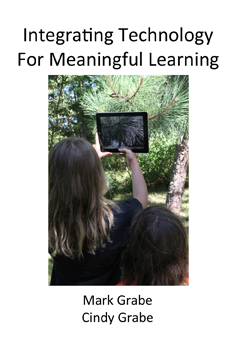The Products
Cindy and I have just released the 6th edition of our book (Integrating Technology for Meaningful Learning) as a Kindle Book. The Kindle Book is available for $9 (Amazon Prime members can get it at no cost for the next 90 days if I understand the terms). This book was developed as a Primer (about half of the length of our earlier editions). We did this purposefully in order to move resources online. The online resources are available to educators (preservice and inservice) at no cost.

The Back Story
This may seem like self-promotion. I suppose it is. However, the backstory may put our project in perspective and be of interest to others whether or not they are interested in the product. By the way, the 5th edition is also still available from Amazon ($107). The price difference is part of the story.
Cindy and I began developing a textbook for preservice teachers in 1994. We published with Houghton-Mifflin in 1995 with a 1996 copyright (Note: The college division of HMCO has been sold and resold a couple of times since then. This is also another part of the story of the book business). We were the first, we think, to use the phrase “integrating technology” and “meaningful” in a book title (we think). If you are curious, check how many current books incorporate these words. I can’t claim the idea of technology integration as now understood was ours. I took the concept from a book called “Mindtools” authored by David Jonassen. I thought his ideas about the use of productivity software in educational settings made a lot of sense and my contribution was to “interpret” and provide classroom examples for educators. Many of the examples came from Cindy’s work as a technology facilitator.
The textbook business is struggling. Some of these problems have been self inflicted. Some are the result of public misunderstanding of what it takes to create a quality product. Sometimes you get what you deserve. Sometimes you find yourself dealing with circumstances and perceptions that you cannot control. We have obviously broken our association with a major publisher to go it on our own. Still, do not get me wrong – I am sympathetic and have friends in the business. The “textbook crisis” is not ALL the fault of the big companies (see Beer Money Ploy).
Anyway, we wanted to transition a book that was a commercial success through 5 editions to a different format. We believed it was the appropriate thing to do given the field we focus on (educational use of technology). If you truly believe that technology can play a meaningful role in learning, it seems disingenuous to make your point using only a book. Our proposal (once blocked after we had secured a commitment from a second publisher because it seemed we were duplicating our content in a way that would amount to competing with ourselves) was to create a Primer and online resources. The idea, which we labelled the $29 textbook, was intended to offer a hybrid product that allowed each components to do what each was best suited to do. We intend a Primer to organize the basic arguments – the more stable elements that benefit from a solid structure and elaboration. The online world is suited to the recent, the speculative, the examples, and the tutorials. It made no sense to incorporate all of these elements in a book. A single, static product did not allow learners to experience demonstrations as they should be experienced. It did not allow them to participate. It did not allow updates until three-years later when the company asked you if you wanted to do a new edition. It is a little more complicated than what I have described here, but I hope the general idea of the benefits of a hybrid approach is clear.
We finally decided enough was enough. We thought we had an agreement to do it our way, but the profit margin on a $29 book and concerns for permissions related to the content we wanted to offer online could not be overcome (lawyer costs must be included in the cost of a textbook). I do not blame the company for their decision. I blame them for the delay in making it. Many instructors looked for our content three years ago. We will have to see if they can find it now.
More as the experiment unfolds.
56 total views
You must be logged in to post a comment.